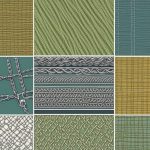Types Of Fabrics
Fabrics are an essential part of our lives, from the clothes we wear to the upholstery on our furniture. There are many different types of fabrics available, each with its own unique properties and characteristics. Understanding the different types of fabrics can help you choose the right one for your project, whether you’re sewing a garment or reupholstering a chair.
Natural fabrics are made from materials that come from plants or animals, such as cotton, wool, and silk. These fabrics are breathable and comfortable to wear, making them a popular choice for clothing. Synthetic fabrics, on the other hand, are made from man-made materials such as polyester and nylon. These fabrics are often more durable and wrinkle-resistant than natural fabrics, making them a popular choice for items like athletic wear and outdoor gear.
Key Takeaways
- There are two main types of fabrics: natural and synthetic.
- Specialty and blended fabrics offer unique properties and characteristics.
- The weight and weaving technique of a fabric can impact its uses and applications.
Natural Fabrics

Natural fabrics are those that are made from natural fibers that are obtained from animals, plants, or minerals. These fabrics are breathable, comfortable, and eco-friendly, making them a popular choice for clothing, bedding, and home decor.
Cotton and Linen
Cotton is a soft, fluffy fiber that grows around the seeds of the cotton plant. It is one of the most commonly used natural fibers in the world and is known for its durability, breathability, and absorbency. Cotton is often blended with other fibers to improve its strength and texture. Linen, on the other hand, is made from the fibers of the flax plant and is known for its strength, coolness, and crispness. It is often used for summer clothing and home decor.
Wool and Silk
Wool is a natural fiber that is obtained from the fleece of sheep and other animals such as alpaca, llama, and cashmere goat. It is known for its warmth, softness, and durability. Wool is often used for winter clothing and home decor. Silk, on the other hand, is a luxurious natural fiber that is obtained from the cocoons of silkworms. It is known for its softness, sheen, and draping quality. Silk is often used for formal clothing and home decor.
Natural fabrics offer a range of benefits over synthetic fabrics. They are biodegradable, renewable, and sustainable, making them an environmentally friendly choice. They are also comfortable to wear, easy to care for, and often hypoallergenic, making them a great choice for people with sensitive skin.
In addition to cotton, linen, wool, and silk, there are many other natural fibers that are used to make fabrics, such as bamboo, hemp, and jute. Each of these fibers has its own unique properties and benefits, making them suitable for different applications.
Synthetic Fabrics
Synthetic fabrics are man-made fabrics that are produced from synthetic fibers. These fibers are made from chemicals and are not derived from natural sources. Synthetic fabrics are durable, wrinkle-resistant, and easy to care for. They are also less expensive than natural fabrics, making them a popular choice in the fashion industry.
Polyester and Nylon
Polyester and nylon are two of the most commonly used synthetic fabrics. Polyester is a synthetic fiber that is made from plastic. It is durable, lightweight, and resistant to shrinking and stretching. Polyester is often used in clothing, bedding, and upholstery fabrics.
Nylon is another synthetic fiber that is made from plastic. It is strong, lightweight, and resistant to abrasion. Nylon is often used in clothing, such as stockings and swimwear, as well as in outdoor gear, such as tents and backpacks.
Rayon and Spandex
Rayon and spandex are two other types of synthetic fabrics. Rayon is a semi-synthetic fiber that is made from wood pulp. It is soft, breathable, and has a silky texture. Rayon is often used in clothing, such as dresses and blouses, as well as in home furnishings, such as curtains and upholstery.
Spandex, also known as elastane, is a synthetic fiber that is made from a type of plastic called polyurethane. It is stretchy, durable, and resistant to damage from sweat and chemicals. Spandex is often used in athletic clothing, such as leggings and sports bras, as well as in swimwear and hosiery.
Overall, synthetic fabrics offer a range of benefits, including durability, affordability, and ease of care. However, they also have some drawbacks, such as being less breathable than natural fabrics and being made from non-renewable resources. When choosing fabrics, it is important to consider both the benefits and drawbacks of each type to find the best option for your needs.
Specialty and Blended Fabrics
Specialty and blended fabrics are gaining popularity among designers and manufacturers as they offer a unique combination of the best qualities of natural and synthetic fibers. These fabrics are made by blending two or more fibers to create a new fabric with improved properties.
Denim and Tweed
Denim is a sturdy cotton twill fabric with a characteristic blue color. It is commonly used to make jeans, jackets, and skirts. Denim is a popular choice for casual wear due to its durability and versatility. Tweed, on the other hand, is a woolen fabric with a soft, open texture. It is often used in traditional outerwear and suits. Tweed has a distinctive pattern that is created by blending different colored wool fibers.
Lace and Velvet
Lace is a delicate fabric made from yarn or thread in an open weblike pattern. It is commonly used in lingerie, wedding dresses, and evening gowns. Lace can be made from a variety of fibers, including cotton, silk, and synthetic materials. Velvet is a luxurious fabric with a soft, plush texture. It is made by weaving two sets of threads together, creating a dense pile that gives it its characteristic feel. Velvet is commonly used in evening wear, upholstery, and drapery.
Specialty and blended fabrics come in a variety of styles and textures, making them suitable for a wide range of applications. Some other popular specialty fabrics include chiffon, leather, suede, and faux fur. Chiffon is a lightweight, sheer fabric typically made from silk or synthetic fibers. Leather and suede are durable materials made from animal hides. Faux fur is a synthetic alternative to real fur, often used in fashion and home decor.
In conclusion, specialty and blended fabrics offer a unique combination of properties that make them a popular choice among designers and manufacturers. Whether you are looking for durability, softness, or a specific texture, there is a specialty fabric that can meet your needs.
Fabric Weights and Uses
Lightweight Fabrics
Lightweight fabrics are typically those that weigh less than 6 oz per square yard. They are often used for summer clothing, such as blouses, skirts, and dresses. Lightweight fabrics are also commonly used for lining jackets and bags. Some examples of lightweight fabrics include cotton voile, rayon challis, and silk chiffon.
Heavyweight Fabrics
Heavyweight fabrics are those that weigh more than 6 oz per square yard. They are commonly used for winter clothing, such as jackets and coats, as well as for furniture upholstery and bedding. Heavyweight fabrics are also used for bags and shoes, as they provide durability and support. Some examples of heavyweight fabrics include denim, canvas, and wool.
When choosing a fabric weight, it is important to consider the intended use of the fabric. Lightweight fabrics are ideal for summer clothing and lining, while heavyweight fabrics are better suited for winter clothing and upholstery. However, it is important to note that fabric weight is not the only factor to consider when choosing a fabric. Other factors, such as fiber content, weave, and texture, can also affect the fabric’s suitability for a particular project.
For example, cotton is a lightweight fabric that is commonly used for summer clothing, but a tightly woven cotton canvas can also be used for heavy-duty bags or upholstery. On the other hand, wool is a heavyweight fabric that is commonly used for winter clothing, but a lightweight wool suiting fabric can be used for tailored garments.
In summary, fabric weight is an important consideration when choosing a fabric for a particular project. Lightweight fabrics are ideal for summer clothing and lining, while heavyweight fabrics are better suited for winter clothing and upholstery. However, it is important to consider other factors, such as fiber content and weave, when choosing a fabric.
Fabric Weaving and Knitting Techniques
Woven Techniques
Woven fabrics are made by interlacing two sets of threads, the warp (lengthwise) and the weft (crosswise). The most common weave is the plain weave, which is created by passing the weft over and under alternate warp threads. This weave is used in cotton, linen, and silk fabrics. Twill weave is another common weave, where the weft passes over two or more warp threads and then under one or more. This creates a diagonal pattern on the fabric surface. Twill weaves are used in denim, gabardine, and herringbone fabrics.
Other types of weaves include the satin weave, where the weft passes over several warp threads before going under one, creating a smooth and shiny surface. Basket weave is created by passing two or more weft threads over and under two or more warp threads, creating a checkerboard pattern. Herringbone weave is similar to twill weave but has a V-shaped pattern.
Knitted Fabrics
Knitted fabrics are made by interlocking loops of yarn. There are two types of knitting techniques: weft knitting and warp knitting. In weft knitting, a single yarn is used to create rows of loops, while in warp knitting, multiple yarns are used to create loops in a vertical direction.
Jersey knit is the most common type of weft knitting, where each loop is formed in a horizontal direction. Purl knit is the opposite of jersey knit, where each loop is formed in a vertical direction. Cable knit is created by twisting stitches to create a braided pattern. Textured knit is a term used to describe any knit fabric that has a pattern or texture on the surface.
In conclusion, understanding the different weaving and knitting techniques used to make fabrics can help you choose the right fabric for your project. Plain weave is the most common weave, while jersey knit is the most common type of knitted fabric. However, there are many other types of weaves and knits that can create unique textures and patterns on the fabric surface.






